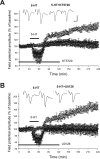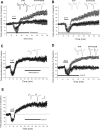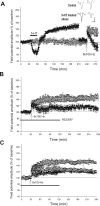5-Hydroxytryptamine induces a protein kinase A/mitogen-activated protein kinase-mediated and macromolecular synthesis-dependent late phase of long-term potentiation in the amygdala
- PMID: 17376972
- PMCID: PMC6672482
- DOI: 10.1523/JNEUROSCI.3908-06.2007
5-Hydroxytryptamine induces a protein kinase A/mitogen-activated protein kinase-mediated and macromolecular synthesis-dependent late phase of long-term potentiation in the amygdala
Abstract
The amygdala is a critical site for the acquisition of learned fear memory in mammals, and the formation and long-term maintenance of fear memories are thought to be associated with changes of synaptic strength in the amygdala. Here we report that serotonin (5-hydroxytryptamine; 5-HT), a modulatory neurotransmitter known to be linked to learned fearful and emotional behavior, has dual effects on excitatory synaptic transmission in the basolateral amygdala. There is an early depression of synaptic transmission lasting 30-50 min, mediated by 5-HT1A, and a late, long-lasting facilitation lasting >5 h in slice recordings, mediated by the 5-HT4 receptor. 5-HT late phase long-term potentiation (L-LTP) is blocked by inhibitors of either protein kinase A (PKA) and/or mitogen-activated kinase (MAPK) and requires new protein synthesis and gene transcription. Moreover, the 5-HT-induced L-LTP in neurons of amygdala is blocked by the actin inhibitor cytochalasin D, suggesting that 5-HT stimulates a cytoskeletal rearrangement. These results show, for the first time, that 5-HT can produce long-lasting facilitation of synaptic transmission in the amygdala and provides evidence for the possible synaptic role of 5-HT in long-term memory for learned fear.
Figures






Similar articles
-
Both protein kinase A and mitogen-activated protein kinase are required in the amygdala for the macromolecular synthesis-dependent late phase of long-term potentiation.J Neurosci. 2000 Sep 1;20(17):6317-25. doi: 10.1523/JNEUROSCI.20-17-06317.2000. J Neurosci. 2000. PMID: 10964936 Free PMC article.
-
Low-frequency stimulation induces a pathway-specific late phase of LTP in the amygdala that is mediated by PKA and dependent on protein synthesis.Learn Mem. 2007 Jul 12;14(7):497-503. doi: 10.1101/lm.593407. Print 2007 Jul. Learn Mem. 2007. PMID: 17626908 Free PMC article.
-
Fear memories induce a switch in stimulus response and signaling mechanisms for long-term potentiation in the lateral amygdala.Eur J Neurosci. 2004 Jul;20(2):549-56. doi: 10.1111/j.1460-9568.2004.03517.x. Eur J Neurosci. 2004. PMID: 15233764
-
BDNF mechanisms in late LTP formation: A synthesis and breakdown.Neuropharmacology. 2014 Jan;76 Pt C:664-76. doi: 10.1016/j.neuropharm.2013.06.024. Epub 2013 Jul 2. Neuropharmacology. 2014. PMID: 23831365 Review.
-
Extracellular signal-regulated kinase, synaptic plasticity, and memory.Rev Neurosci. 2001;12(4):327-45. doi: 10.1515/revneuro.2001.12.4.327. Rev Neurosci. 2001. PMID: 11783718 Review.
Cited by
-
Social interactions determine postural network sensitivity to 5-HT.J Neurosci. 2010 Apr 21;30(16):5603-16. doi: 10.1523/JNEUROSCI.0367-10.2010. J Neurosci. 2010. PMID: 20410113 Free PMC article.
-
Emotional memory impairments in a genetic rat model of depression: involvement of 5-HT/MEK/Arc signaling in restoration.Mol Psychiatry. 2012 Feb;17(2):173-84. doi: 10.1038/mp.2010.131. Epub 2011 Jan 18. Mol Psychiatry. 2012. PMID: 21242991 Free PMC article.
-
Chronic Enhancement of Serotonin Facilitates Excitatory Transcranial Direct Current Stimulation-Induced Neuroplasticity.Neuropsychopharmacology. 2016 Apr;41(5):1223-30. doi: 10.1038/npp.2015.270. Epub 2015 Sep 2. Neuropsychopharmacology. 2016. PMID: 26329381 Free PMC article. Clinical Trial.
-
Serotonin, Amygdala and Fear: Assembling the Puzzle.Front Neural Circuits. 2016 Apr 5;10:24. doi: 10.3389/fncir.2016.00024. eCollection 2016. Front Neural Circuits. 2016. PMID: 27092057 Free PMC article. Review.
-
Role of cAMP/PKA pathway and T-type calcium channels in the mechanism of action of serotonin in human adrenocortical cells.Mol Cell Endocrinol. 2017 Feb 5;441:99-107. doi: 10.1016/j.mce.2016.10.008. Epub 2016 Oct 12. Mol Cell Endocrinol. 2017. PMID: 27743992 Free PMC article.
References
-
- Amorapanth P, LeDoux JE, Nader K. Different lateral amygdala outputs mediate reactions and actions elicited by a fear-arousing stimulus. Nat Neurosci. 2000;3:74–79. - PubMed
-
- Andrade R, Chaput Y. 5-Hydroxytryptamine 4-like receptors mediate the slow excitatory response to serotonin in the rat hippocampus. J Pharmacol Exp Ther. 1991;257:930–937. - PubMed
-
- Azmitia EC, Gannon PJ. The primate serotonergic system: a review of human and animal studies and a report on Macaca fascicularis. Adv Neurol. 1986;43:407–468. - PubMed
Publication types
MeSH terms
Substances
Grants and funding
LinkOut - more resources
Full Text Sources
